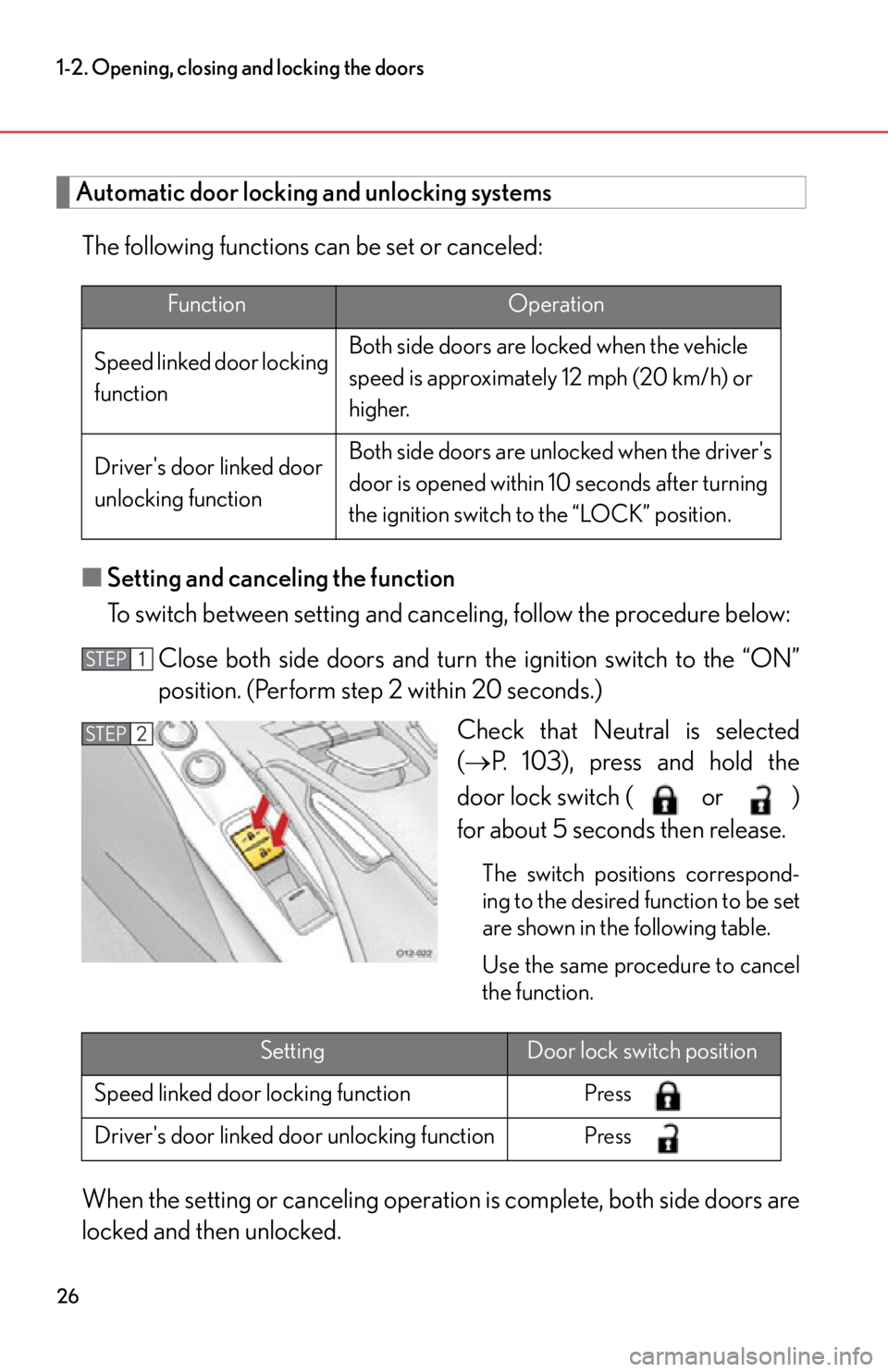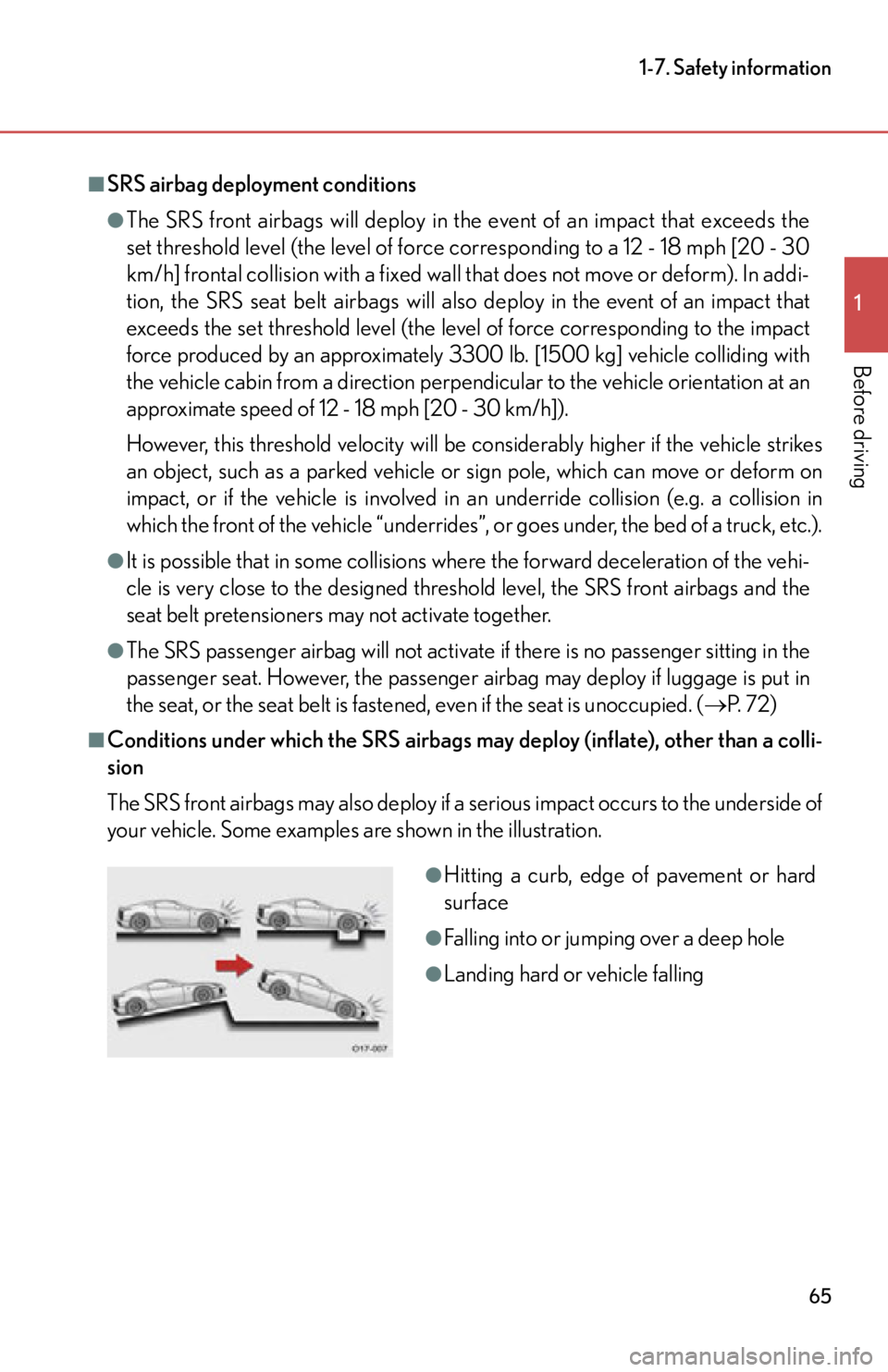ESP lexus LFA 2012 Technical Information / LEXUS 2012 LFA OWNERS MANUAL (OM77006U)
[x] Cancel search | Manufacturer: LEXUS, Model Year: 2012, Model line: LFA, Model: Lexus LFA 2012Pages: 420, PDF Size: 5.02 MB
Page 1 of 420

Driving pleasure so intense that motive performance becomes emo-
tive performance - this is the gift that the LFA offers its owner.
Equipped with an array of individualizing traits that combine state-of-
the-art technology and old-world an alog charm, the LFA was devel-
oped with enduring passion to be the realization of Lexus’ key con-
cepts of “Joy” and “Leading edge”.
The LFA before you contains endless possibilities, waiting only for
your command to transform dreams into reality. Knowing the LFA
inside and out is the key to harnessing the LFA’s power and enjoying
its full potential.
Instantaneous response perfectly in line with driver intentions.
Direct steering feel born fr om a rigid, lightweight body.
Complete confidence in the vehicle’s driving performance for the
freedom to focus entirely on driving.
Engaging interaction through an infinite variety of meter messages.
These promises add a new layer of stimulus to the owner’s everyday
life. Please think of this Owner’s Ma nual as the key to fulfilling these
promises. The information contained here is a guide to keeping the
LFA in its best possible condition, allowing you to enjoy the LFA’s
traits and technologies long into the future. As you come to know
more about the LFA, your relationship with this unique vehicle and
your enjoyment in its company will surely increase.
Picture the LFA years from now.
May it be just as precious to you then as it is today.
Dear owner of the LFA
Page 18 of 420

16
Accessories, spare parts and modification of your Lexus
A wide variety of non-genuine spare parts and accessories for Lexus vehicles are
currently available in the market. You should know that Toyota does not warrant
these products and is not responsible for their performance, repair, or replacement,
or for any damage they may cause to, or adverse effect they may have on, your
Lexus vehicle.
This vehicle should not be modified with non-genuine Lexus products. Modification
with non-genuine Lexus products could affect its performance, safety or durability,
and may even violate governmental regula tions. In addition, damage or perfor-
mance problems resulting from the modification may not be covered under war-
ranty.
Scrapping of your Lexus
The SRS airbag and seat belt pretensioner devices in your Lexus contain explosive
chemicals. If the vehicle is scrapped with the airbags and seat belt pretensioners left
as they are, this may cause an accident such as fire. Be sure to have the systems of
the SRS airbag and seat belt pretensioner removed and disposed of by a qualified
service shop or by your Lexus deal er before you scrap your vehicle.
Perchlorate Material
Special handling may apply, See www.dtsc.ca.gov/hazardouswaste/perchlorate.
Your vehicle has components that may contain perchlorate. These components may
include airbags, seat belt pretensioners, and wireless remote control batteries.
Page 26 of 420

24
1-2. Opening, closing and locking the doors
■Certification for wireless remote controlFor vehicles sold in the U.S.A.
FCC ID: HYQ12BDH FCC ID: HYQ13BDC
NOTE:
This device complies with part 15 of the FCC Rules. Operation is subject to the fol-
lowing two conditions: (1) This device may not cause harmful interference, and (2)
this device must accept any interference received, including interference that may
cause undesired operation.
FCC WARNING:
Changes or modifications not expressly approved by the party responsible for
compliance could void the user's authority to operate the equipment.
For vehicles sold in Canada
NOTE:
Operation is subject to the following two conditions: (1) this device may not cause
interference, and (2) this device must accept any interference, including interfer-
ence that may cause undesired operation of the device.
Page 28 of 420

26
1-2. Opening, closing and locking the doors
Automatic door locking and unlocking systemsThe following functions can be set or canceled:
■ Setting and canceling the function
To switch between setting and canceling, follow the procedure below:
Close both side doors and turn the ignition switch to the “ON”
position. (Perform step 2 within 20 seconds.) Check that Neutral is selected
(P. 103), press and hold the
door lock switch ( or )
for about 5 seconds then release.
The switch positions correspond-
ing to the desired function to be set
are shown in the following table.
Use the same procedure to cancel
the function.
When the setting or canceling operatio n is complete, both side doors are
locked and then unlocked.
FunctionOperation
Speed linked door locking
function Both side doors are locked when the vehicle
speed is approximately 12 mph (20 km/h) or
higher.
Driver's door linked door
unlocking function Both side doors are unlocked when the driver's
door is opened within 10 seconds after turning
the ignition switch to the “LOCK” position.
STEP1
STEP2
SettingDoor lock switch position
Speed linked door locking function
Press
Driver's door linked door unlocking functionPress
Page 29 of 420

27
1-2. Opening, closing and locking the doors
1
Before driving
■Door unlock indicator
This indicator turns off when the doors are locked or 30 seconds after the ignition
switch is turned to the “LOCK” position.
■Impact detection door lock release system
In the event that the vehicle is subject to a strong impact, both side doors are
unlocked. Depending on the force of the impact or the type of accident, however,
the system may not operate.
■If a wrong key is used
The key cylinder rotates freely to isolate the inside mechanism if a wrong key is
inserted into the key cyli nder and forcibly rotated.
■Customization that can be conf igured at your Lexus dealer
Settings (e.g. unlocking function using a key) can be changed.
(Customizable features P. 383)
CAUTION
■To prevent an accident
Observe the following precautions while driving the vehicle.
Failing to do so may result in a door open ing and an occupant falling out, resulting in
death or serious injury.
●Always use a seat belt.
●Always lock both side doors.
●Ensure that both side doors are properly closed.
●Do not pull the lever of the doors while driving.
The doors may be opened and the passengers are thrown out of the vehicle and it
may result in serious injury or death.
Be especially careful for both side doors, as the doors may be opened even if the
door lock switch is locked.
■When opening or closing the doors
Be careful not to get your fingers or na ils caught between the door handle and door
panel.
Page 30 of 420

28
1-2. Opening, closing and locking the doors
NOTICE
■When entering or exiting your vehicle
Be careful not to kick or step on the vehicle
body as doing so may cause damage to the
vehicle and its coating.
Be especially careful with the rocker molding
when entering or exiting the vehicle, as it may
be easily hit.
Page 56 of 420

54
1-6. Theft deterrent system
■Certifications for the engine immobilizer system For vehicles sold in the U.S.A.
FCC ID: MOZRI-33BTY
This device complies with Part 15 of the FCC Rules. Operation is subject to the fol-
lowing two conditions: (1) this device may not cause harmful interference, and (2)
this device must accept any interference received, including interference that may
cause undesired operation.
FCC WARNING:
Changes or modifications not expressly approved by the party responsible for
compliance could void the user's authority to operate the equipment.
For vehicles sold in Canada
Operation is subject to the following two conditions: (1) this device may not cause
interference, and (2) this device must accept any interference, including interfer-
ence that may cause undesired operation of the device.
NOTICE
■To ensure the system operates correctly
Do not modify or remove the system. If mo dified or removed, the proper operation
of the system cannot be guaranteed.
Page 66 of 420

64
1-7. Safety information
The main SRS airbag system components are shown above. The SRS air-
bag system is controlled by the airb ag sensor assembly. The airbag sen-
sor assembly consists of a safing sensor and an airbag sensor.
In certain types of severe frontal or side impacts, the SRS airbag system
triggers the airbag inflators. A chemica l reaction in the inflators quickly
fills the airbags with non-toxic gas to he lp restrain the motion of the occu-
pants.
■If the SRS airbags deploy (inflate)
●Bruising and slight abrasion s may result from contact with a deploying (inflating)
SRS airbag.
●A loud noise and white powder will be emitted.
●Parts of the airbag module (steering wheel , airbag cover and inflator) as well as
the seats may be hot for several minutes. The airbag itself may also be hot.
●The windshield may crack.
●For Safety Connect subscribers, if the SRS airbags deploy or in the event of a
severe rear-end collision, the system is designed to send an emergency call to
the response center, notifying them of the vehicle’s location (without needing to
push the “SOS” button) and an agent will attempt to speak with the occupants
to ascertain the level of emergency and assistance required. If the occupants
are unable to communicate, the agent automatically treats the call as an emer-
gency and helps to dispatch the necessary emergency services. ( P. 2 1 9 )
Page 67 of 420

65
1-7. Safety information
1
Before driving
■SRS airbag deployment conditions
●The SRS front airbags will deploy in the event of an impact that exceeds the
set threshold level (the level of force corresponding to a 12 - 18 mph [20 - 30
km/h] frontal collision with a fixed wall that does not move or deform). In addi-
tion, the SRS seat belt airbags will also deploy in the event of an impact that
exceeds the set threshold level (the level of force corresponding to the impact
force produced by an approximately 3300 lb. [1500 kg] vehicle colliding with
the vehicle cabin from a direction perpendicular to the vehicle orientation at an
approximate speed of 12 - 18 mph [20 - 30 km/h]).
However, this threshold velocity will be considerably higher if the vehicle strikes
an object, such as a parked vehicle or sign pole, which can move or deform on
impact, or if the vehicle is involved in an underride collision (e.g. a collision in
which the front of the vehicle “underrides”, or goes under, the bed of a truck, etc.).
●It is possible that in some collisions where the forward deceleration of the vehi-
cle is very close to the designed thresh old level, the SRS front airbags and the
seat belt pretensioners ma y not activate together.
●The SRS passenger airbag will not activate if there is no passenger sitting in the
passenger seat. However, the passenger airbag may deploy if luggage is put in
the seat, or the seat belt is fastened , even if the seat is unoccupied. (P. 7 2 )
■Conditions under which the SRS airbags may deploy (inflate), other than a colli-
sion
The SRS front airbags may also deploy if a serious impact occurs to the underside of
your vehicle. Some examples are shown in the illustration.
●Hitting a curb, edge of pavement or hard
surface
●Falling into or jumping over a deep hole
●Landing hard or vehicle falling
Page 70 of 420

68
1-7. Safety information
CAUTION
■SRS airbag precautions
Observe the following precautions regarding the airbags.
Failure to do so may cause death or serious injury.
●The driver and passenger in the vehicle must wear their seat belts properly.
The SRS airbags are supplemental devices to be used with the seat belts.
●The SRS driver airbag deploys with considerable force, and can cause death or
serious injury especially if the driver is very close to the airbag. The National
Highway Traffic Safety Administration (“NHTSA”) advises:
Since the risk zone for the driver airbag is the first 2 - 3 in. (50 - 75 mm) of infla-
tion, placing yourself 10 in. (250 mm) from your driver airbag provides you with a
clear margin of safety. This distance is measured from the center of the steering
wheel to your breastbone. If you sit less than 10 in. (250 mm) away now, you can
change your driving position in several ways:
• Move your seat to the rear as far as you can while still reaching the pedals
comfortably.
• Slightly recline the back of the seat. Although vehicle designs vary, many dr ivers can achieve the 10 in. (250 mm)
distance, even with the driver’s seat all the way forward, simply by reclining
the back of the seat somewhat. If reclining the back of your seat makes it hard
to see the road, raise yourself by using a firm, or raise the seat if your vehicle
has that feature.
• If your steering wheel is adjustable, ti lt it downward. This points the airbag
toward your chest instead of your head and neck.
The seat should be adjusted as recommended by NHTSA above, while still main-
taining control of the foot pedals, steering wheel, and your view of the instrument
panel controls.